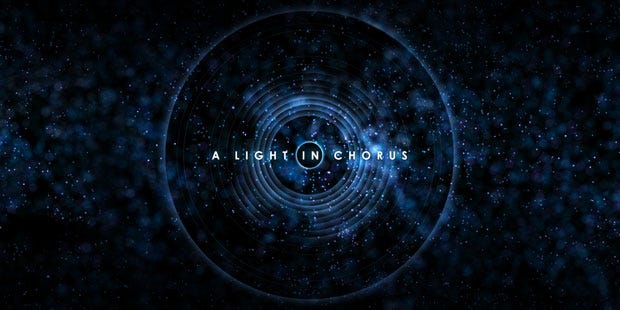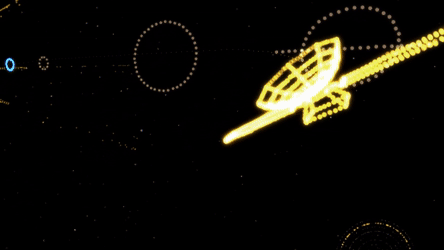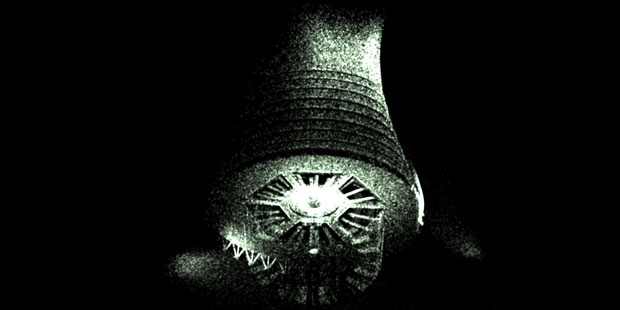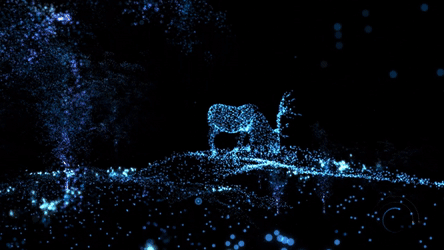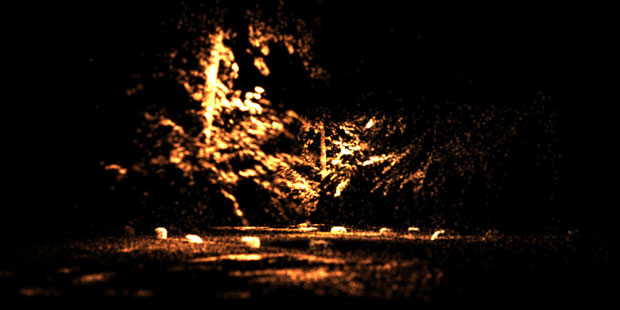A Light In Chorus Gets Cosmic New Direction
Point [cloud] and click
A Light In Chorus [official site] was one of the first games I got excited about after joining RPS full-time. Development went quiet for a while and I kept wondering whether the game was still going to come into being. Now the team behind the dreamy point-cloud project have reworked the premise, secured some funding and the whole thing has very much pinged back onto the radar.
The new underpinnings of the game are inspired by the cosmic message-in-a-bottle aspects of the NASA Voyager program so I sent out a probe email of my own to investigate this new direction.
When I played a build of the game back at EGX in 2014 it was a case of exploring a landscape made from dots of light and being able to swap bits of scenery and objects for others in your inventory. At the time I wrote that "The team are currently considering their next move. Part of that will likely be keeping an eye on the tension between a free-er kind of exploration and actual puzzle solving elements."
It was a really cool idea and the presentation was lovely but it felt like the team maybe hadn't quite found the story or the concept to hinge those things around. As per the press release they sent out yesterday:
"A lot has changed over the last year, and we've been keeping very quiet about things. Largely this has been a side effect of deciding to re-invent the games premise. It's not a total do-over by any means, but it's been hard work trying to find a fitting narrative accompaniment that remains true to the spirit of the design goals we began with."
Your new goal in the game is "Through strange new eyes, to explore a far future Earth, now swallowed by the oceans.Your only guide: a faulty old record player (loosely based on the Golden Record)- capable of transforming the world around you into a musical light show, at the press of a button.
"But the things it shows you, the bright, beautiful colours and sounds, are not what you've found here... what's this device not telling you?"
I asked one of the developers, Eliott Johnson, to talk me through the evolution of the game and how they ended up with this Voyager-inspired solution.
Here's the mechanical side of the explanation. It's really interesting backgroundy stuff which I like because it expresses the problem of having a cool aspect and trying to find the right... conceptual home? framework?... for it.
Johnson: "We’d been making incremental changes to how mechanical things worked for a really long time. The main problem was how to deal with overlapping space. For me, it was a really central part of the game’s design: the idea that the worlds you travelled through, would all be stacked in the same space- so moving in one, meant moving in all of them, and would open up a bunch of gameplay possibilities.
"But we’d been trying to get the player to have this “aha! it’s all the same space” moment- just through solving a bunch of abstract puzzles- we’d tried “magic” doors, swappable morphing objects, lampposts you’d have to stand under, loads of stuff. None of it really quite worked. We‘d get a lot of positive feedback from playtests, but it was mostly focused on the visuals, when there was this bigger design tangle lurking underneath.
"The new design does away with all the obfuscation- you hold a button and everything is transformed, then when you release it, it goes back. And it’s all part of this narrative mapping too- you’re progressing the playhead/changing tracks on this record. It’s ridiculously, almost embarrassingly simple, but the first time we tried it, it was more gratifying than anything else we’d done, especially once we tied it to the way the particles moved.
"We’re working on giving it a bit more nuance now (to avoid fatigue), but the transience of having to hold something down added a really interesting physical dimension. It has a spring-y ness to it beyond the button spring, like pressing the button is holding back this unstoppable form.
"Once the main mechanic changed, one of the biggest side effects was that the cognitive load was reduced (part of the puzzle stuff had been about working out what you’re supposed to do) so it free’d up a lot more room to focus on plot."
So that set the scene and then the idea of a sonic map came into play.
Johnson: "This is where Voyager starts to creep in. At first I was making environmental changes - setting everything underwater. You were going to be exploring a flooded future Earth and performing this “time travel” trick where you rewound to a different past state of the world. But we were limited in terms of what we could explore visually - you’re kind of constrained by the geography - and it was missing the musical component that we’d wanted, all these spaces singing together. The "in chorus" bit, basically.
"Originally we’d been trying to apply some of the ideas in Bruce Chatwin’s book The Songlines to the game. It describes this aboriginal way of mapping Australia, where song-like stories become alternate ways to read the landscape. It’s where the stag began life - as a musical centerpoint to the story - though now its role in the narrative is a little different - not so pronounced.
"I was trying to come up with a rationale for the player being able to do this time travel thing, and being an alien was one option of a few, but there was still some explaining to do. It took a little while to come around to the idea (aliens are such a video game cliché) but it hung around at the back of my head for a few weeks until it suddenly clicked.
"I remembered listening to this great Radiolab episode where they’d interviewed Ann Druyan and Tim Ferris about putting the Voyager records together, and the weird mix of music and sounds on there. It resembled a collage, something Mat and I had talked about as a good way to describe a lot of how A Light In Chorus functioned, literally a 'collage of sound and space'.
As a whole it all just seemed to work nicely with other things in the game - using a song as a map, seeing the familiar world in a different way, the mixed fidelity of the point clouds, stuff lingering on the edges of recognition. And this was before I’d done any 'proper' research.
"The more I dug, the richer a premise it became - the task that the Voyager Record team had almost acts as a game design brief in itself. In Murmurs of Earth (the book published to coincide with the Voyager launch), they quote Jonathan Eberhart from Science News:
Describe the world. Not just that multi-colored ball in the spacecraft photos, but the world - its place in space, its diverse biota, its wide-ranging cultures with their lifestyles, arts and technologies - everything, or at least enough to get the idea across. And do it in one long-playing record.
Oh, there’s one stipulation: Assume not only that your audience doesn’t speak your language, but that it has never even heard of the Earth or the rest of the solar system. An audience that lives, say, on a planet orbiting another star, light-years from anything you would recognize as home.
"It’s a similar way to how you have to think about a person playing your game sometimes - as an alien, trying to work out the rules of this world you’re presenting - especially if you don’t want to put walls of instructional text everywhere. It’s certainly something I’ve found to be helpful.
"Aside from all of that though, maybe the most interesting thing about the Voyager records to us is their flaws. It’s remarkable that they were put together in just months, but it also really shows in some of the content (the Murmurs book gives a terrific description of problems they encountered). Then there’s the problem that this 'ambassador for Earth' was predominantly curated by Americans. It makes you think about the things that had to be left out, either by mistake or deliberately. It’s these discrepancies between reality and its presentation that we think will make for such a captivating, if unreliable tour guide."
